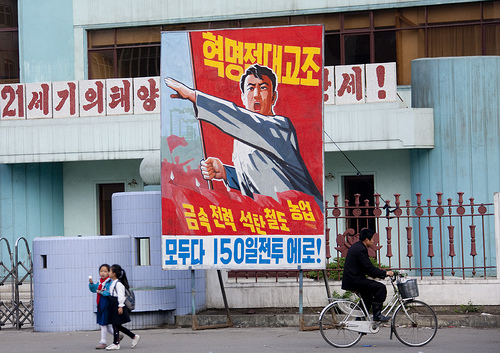In Russia’s largest port city on the Pacific Ocean, Vladivostok, several small-framed Asian men are bustling around a half-built apartment building, trying to move large metal beams. They are North Koreans sent out by their government to earn much-needed foreign currency for the country.
Kim Dong Gil came from North Korea’s second largest city of Hamhung. He brags that North Korean workers have the best skills in the Russian construction market, which is also filled with laborers from Central Asia and Vietnam.
The estimated 5,000 North Koreans in Vladivostok come from various backgrounds and even include doctors.
“I didn’t have any construction skills since I used to be with the military,” said Kim Soon Nam, who served in the army back home. “I learned from scratch when I arrived here. I got trained by a really young person who used to curse and swear at me all the time.”
Despite the stress of living and working in a foreign country, the North Koreans have come to appreciate the culture of capitalism.
“Back home I couldn’t make money even if I wanted to. But here if I work hard, I can make a dozen times more,” explained Han Jong Rok.
Choi Jong-kun, an assistant professor of political science at Yonsei University in Seoul, says money is just one reason to leave home. The other is improving one’s status among North Korea’s political elite.
“If they bring in more money, then they would sort of have sort of upward mobility in their social class,” explained Choi Jong-kun.
North Korea does not reveal significant economic data, but exporting workers is considered a key source of hard foreign currency.
A report by the Korea Institute for International Economic Policy in Seoul estimated in 2007 that Pyongyang earns at least $40 million to $60 million a year from labor exports. Outside of Russia, the institute has tracked North Korean workers in Kuwait, the United Arab Emirates, Qatar, Bangladesh, China and Mongolia.
In Vladivostok, every North Korean worker is required to pay the Pyongyang government around $800 each month.
Kim Soon Nam says he works extra hours to make sure he has money for himself.
“If we want to save some money, we have to work Sundays and holidays, too,” he said. “We must earn a lot of money no matter what. North Koreans have to work from 8 am to 10 pm.”
The North Koreans in Vladivostok usually get a five-year visa, but many get extensions to earn more money. They sleep in dormitories and live to work, spending much of their time outside the construction sites doing extra jobs in local Russian homes.
Kim Chul Woong, a welder, says he is willing to sacrifice time from his family back in Pyongyang to give his son opportunities few North Koreans enjoy, like a computer.
“The video footage on the computer can enhance children’s intellectual development, but I don’t have the kind of money,” he said. “When I go back home after working in Russia I’ll have a good amount of money. I can buy expensive stuff for my son. If he wants to do music I can buy him a violin or a guitar.”
He says he is taking advantage of the work while he can get it. Kim Chul Woong says the construction jobs are dwindling in Russia because of the economic crisis. There is also greater competition from newly arriving Central Asians who are as hungry for dollars as he is.

